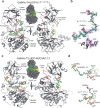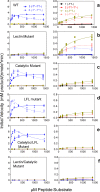Structural and Mechanistic Insights into the Catalytic-Domain-Mediated Short-Range Glycosylation Preferences of GalNAc-T4
- PMID: 30276263
- PMCID: PMC6161044
- DOI: 10.1021/acscentsci.8b00488
Structural and Mechanistic Insights into the Catalytic-Domain-Mediated Short-Range Glycosylation Preferences of GalNAc-T4
Abstract
Mucin-type O-glycosylation is initiated by a family of polypeptide GalNAc-transferases (GalNAc-Ts) which are type-II transmembrane proteins that contain Golgi luminal catalytic and lectin domains that are connected by a flexible linker. Several GalNAc-Ts, including GalNAc-T4, show both long-range and short-range prior glycosylation specificity, governed by their lectin and catalytic domains, respectively. While the mechanism of the lectin-domain-dependent glycosylation is well-known, the molecular basis for the catalytic-domain-dependent glycosylation of glycopeptides is unclear. Herein, we report the crystal structure of GalNAc-T4 bound to the diglycopeptide GAT*GAGAGAGT*TPGPG (containing two α-GalNAc glycosylated Thr (T*), the PXP motif and a "naked" Thr acceptor site) that describes its catalytic domain glycopeptide GalNAc binding site. Kinetic studies of wild-type and GalNAc binding site mutant enzymes show the lectin domain GalNAc binding activity dominates over the catalytic domain GalNAc binding activity and that these activities can be independently eliminated. Surprisingly, a flexible loop protruding from the lectin domain was found essential for the optimal activity of the catalytic domain. This work provides the first structural basis for the short-range glycosylation preferences of a GalNAc-T.
Conflict of interest statement
The authors declare no competing financial interest.
Figures




Similar articles
-
The interdomain flexible linker of the polypeptide GalNAc transferases dictates their long-range glycosylation preferences.Nat Commun. 2017 Dec 5;8(1):1959. doi: 10.1038/s41467-017-02006-0. Nat Commun. 2017. PMID: 29208955 Free PMC article.
-
Mucin-type O-glycosylation is controlled by short- and long-range glycopeptide substrate recognition that varies among members of the polypeptide GalNAc transferase family.Glycobiology. 2016 Apr;26(4):360-76. doi: 10.1093/glycob/cwv108. Epub 2015 Nov 26. Glycobiology. 2016. PMID: 26610890 Free PMC article.
-
The lectin domain of the polypeptide GalNAc transferase family of glycosyltransferases (ppGalNAc Ts) acts as a switch directing glycopeptide substrate glycosylation in an N- or C-terminal direction, further controlling mucin type O-glycosylation.J Biol Chem. 2013 Jul 5;288(27):19900-14. doi: 10.1074/jbc.M113.477877. Epub 2013 May 20. J Biol Chem. 2013. PMID: 23689369 Free PMC article.
-
Polypeptide GalNAc-Ts: from redundancy to specificity.Curr Opin Struct Biol. 2019 Jun;56:87-96. doi: 10.1016/j.sbi.2018.12.007. Epub 2019 Jan 28. Curr Opin Struct Biol. 2019. PMID: 30703750 Free PMC article. Review.
-
Recent structural and mechanistic insights into protein O-GalNAc glycosylation.Biochem Soc Trans. 2016 Feb;44(1):61-7. doi: 10.1042/BST20150178. Biochem Soc Trans. 2016. PMID: 26862189 Review.
Cited by
-
Engineering Orthogonal Polypeptide GalNAc-Transferase and UDP-Sugar Pairs.J Am Chem Soc. 2019 Aug 28;141(34):13442-13453. doi: 10.1021/jacs.9b04695. Epub 2019 Aug 16. J Am Chem Soc. 2019. PMID: 31373799 Free PMC article.
-
An unusual dual sugar-binding lectin domain controls the substrate specificity of a mucin-type O-glycosyltransferase.Sci Adv. 2024 Mar;10(9):eadj8829. doi: 10.1126/sciadv.adj8829. Epub 2024 Feb 28. Sci Adv. 2024. PMID: 38416819 Free PMC article.
-
Exploring the glycosylation of mucins by use of O-glycodomain reporters recombinantly expressed in glycoengineered HEK293 cells.J Biol Chem. 2022 Apr;298(4):101784. doi: 10.1016/j.jbc.2022.101784. Epub 2022 Mar 2. J Biol Chem. 2022. PMID: 35247390 Free PMC article.
-
Mucins and the Microbiome.Annu Rev Biochem. 2020 Jun 20;89:769-793. doi: 10.1146/annurev-biochem-011520-105053. Epub 2020 Apr 3. Annu Rev Biochem. 2020. PMID: 32243763 Free PMC article. Review.
-
Role of GALNT4 in protecting against cardiac hypertrophy through ASK1 signaling pathway.Cell Death Dis. 2021 Oct 22;12(11):980. doi: 10.1038/s41419-021-04222-5. Cell Death Dis. 2021. PMID: 34675184 Free PMC article.
References
-
- Kato K.; Jeanneau C.; Tarp M. A.; Benet-Pages A.; Lorenz-Depiereux B.; Bennett E. P.; Mandel U.; Strom T. M.; Clausen H. Polypeptide GalNAc-transferase T3 and familial tumoral calcinosis. Secretion of fibroblast growth factor 23 requires O-glycosylation. J. Biol. Chem. 2006, 281 (27), 18370–18377. 10.1074/jbc.M602469200. - DOI - PubMed
-
- Khetarpal S. A.; Schjoldager K. T.; Christoffersen C.; Raghavan A.; Edmondson A. C.; Reutter H. M.; Ahmed B.; Ouazzani R.; Peloso G. M.; Vitali C.; Zhao W.; Somasundara A. V.; Millar J. S.; Park Y.; Fernando G.; Livanov V.; Choi S.; Noe E.; Patel P.; Ho S. P.; Myocardial Infarction Exome Sequencing S.; Kirchgessner T. G.; Wandall H. H.; Hansen L.; Bennett E. P.; Vakhrushev S. Y.; Saleheen D.; Kathiresan S.; Brown C. D.; Abou Jamra R.; LeGuern E.; Clausen H.; Rader D. J. Loss of Function of GALNT2 Lowers High-Density Lipoproteins in Humans, Nonhuman Primates, and Rodents. Cell Metab. 2016, 24 (2), 234–245. 10.1016/j.cmet.2016.07.012. - DOI - PMC - PubMed
-
- Pedersen N. B.; Wang S.; Narimatsu Y.; Yang Z.; Halim A.; Schjoldager K. T.; Madsen T. D.; Seidah N. G.; Bennett E. P.; Levery S. B.; Clausen H. Low density lipoprotein receptor class A repeats are O-glycosylated in linker regions. J. Biol. Chem. 2014, 289 (25), 17312–17324. 10.1074/jbc.M113.545053. - DOI - PMC - PubMed
Grants and funding
LinkOut - more resources
Full Text Sources

